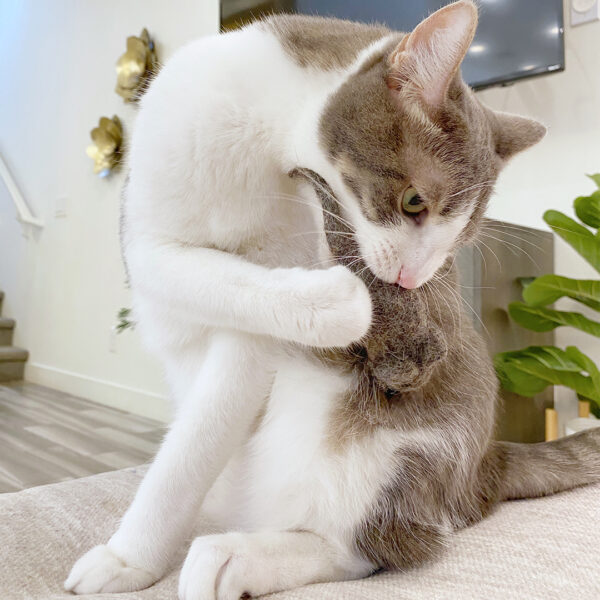
Top Picks for Feline Fun and Well-Being
Cats love to play, and toys are a big part of their lives. But not all cat toys are safe for our cats. Some toys can pose risks if they break or have small parts that cats might swallow. That’s why it’s key to pick toys that are both fun and safe.
The safest cat toys are those made of sturdy materials that can’t be easily torn apart or swallowed. Soft toys filled with catnip, wands with short strings, and sturdy balls are good choices. These toys let cats act on their natural urges to hunt, chase, and pounce without putting them at risk.
Picking the right toys helps keep cats happy and healthy. Safe toys give cats a chance to play and stay active. This can help with weight control and keep their minds sharp. It’s also a great way for cats and their parents to bond and have fun together.
Key Takeaways
- Safe cat toys are made of strong materials that won’t break into small pieces
- Playing with safe toys helps cats stay active and healthy
- Choosing the right toys can strengthen the bond between cats and their parents
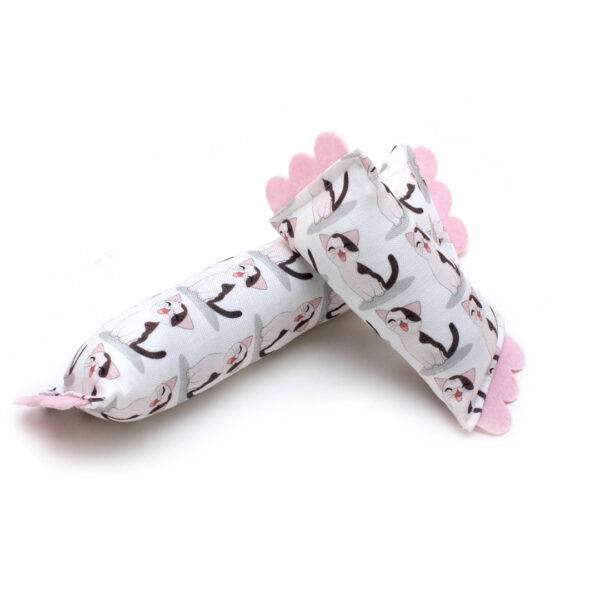
Safety Considerations for Cat Toys
Cat toys need to be chosen carefully to keep pets safe during play. Examining materials, size, and durability helps prevent accidents and injuries.
Materials and Durability
Cat toys should be made of safe, non-toxic materials. Plush toys with polyester stuffing are good choices. Sisal rope is great for scratching posts. Avoid toys with small parts that can come loose.
Cotton and wool toys are safe but may not last long with heavy play. Toys with Velcro can be risky if cats chew on them. Look for sturdy construction that can withstand biting and clawing.
Check toys often for signs of wear. Replace them when they start to fall apart. This prevents cats from swallowing pieces that break off.
Safest Cat Toy Size and Choking Hazards
The right size toy is key to safety. Toys should be big enough that cats can’t swallow them whole. Small objects like marbles or jingle bells inside toys can be dangerous if they come out.
Avoid toys with long strings or wires. These can wrap around a cat’s neck or paws. Rubber bands are also risky and should not be used as cat toys.
Here’s a quick guide to toy sizes:
- Too small: Anything smaller than 1 inch
- Just right: Between 1-4 inches
- Too big: Larger than your cat’s head
Cat Toy sAfety: Supervised Play and Risks
Always watch your cat when they play with new toys. This lets you spot any problems quickly. Some cats may try to eat parts of toys, which can be dangerous.
Put toys away when you’re not around to supervise. This is especially important for string toys and feather wands. These can be fun but risky if cats play with them alone.
Set up a safe play area away from furniture edges and cords. Remove anything that could fall or be knocked over during play. Make sure there’s enough space for your cat to run and jump safely.
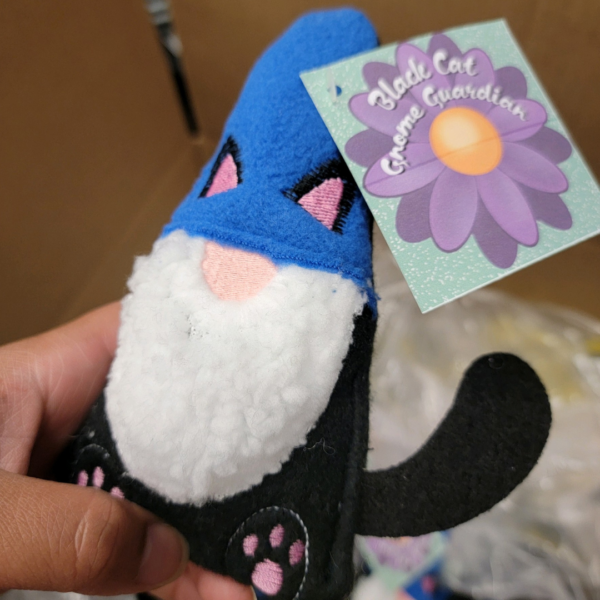
Types of Cat Toys
Cat toys come in many shapes and sizes to keep felines active and entertained. Different types target specific play behaviors and needs. The right mix of toys can provide mental and physical stimulation for cats.
Interactive Toys
Interactive toys get cats moving and thinking. Laser pointers are fun but should be used carefully. Cats may get frustrated if they can’t “catch” the light. Ball tracks ( our Eddie’s favorite!) let cats bat and chase rolling balls. Robotic mice mimic prey movement to spark hunting instincts.
Feather wands encourage jumping and pouncing. Crinkly toys make noise when batted around. Catnip-filled toys add extra excitement for many cats. Battery-operated toys that move on their own can keep cats busy when alone.
Chew and Teething Toys
Chew toys help cats satisfy their urge to bite and chew. They’re great for teething kittens. Soft rubber toys are a safe option. Some have nubs to massage gums. Rope toys let cats gnaw safely.
Avoid small parts that could be swallowed. Don’t give cats human teething toys or rubber bands. These can be dangerous if ingested. Choose cat-specific chew toys made of durable materials.
Wand and String Toys
Wand toys have a stick with a string and toy attached. They spark cats’ prey drive. Feathers, fabric strips, or small stuffed toys dangle enticingly. Cats love to chase, leap, and grab at the moving target.
Keep sessions short to avoid overexertion. Always put wand toys away after play. Long strings can be a choking hazard if left out. Supervise play with any toy that has string attached.
Puzzle and Feeder Toys
Puzzle toys challenge cats mentally. They hide treats or kibble for cats to find. This mimics natural foraging behavior. Some have sliding parts or holes to reach into. Others dispense food as cats bat them around.
Puzzle feeders slow down fast eaters. They turn mealtime into a fun game. Start with easy puzzles and work up to harder ones. Rotate puzzle toys to keep cats interested.
SAfe Cat Scratching Toys
Scratching is a natural cat behavior. Scratching toys give cats a proper outlet. Posts come in many materials like sisal rope, cardboard, or carpet. Some cats prefer vertical posts, others like flat pads.
Try different textures to see what your cat likes best. Place scratchers near furniture to redirect clawing. Catnip-infused scratchers may attract cats more. Replace scratchers when they get worn out.
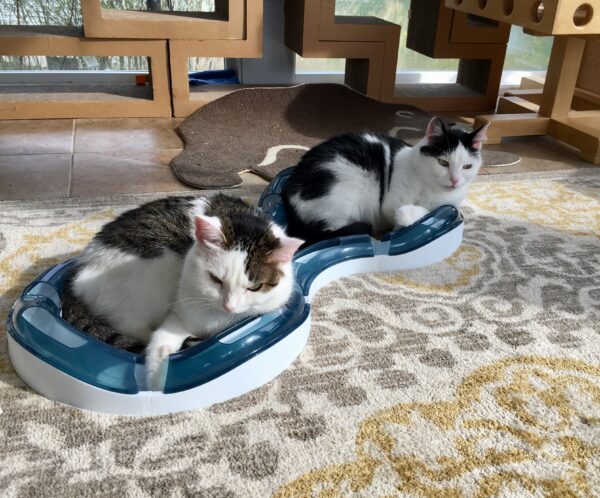
Factors Influencing Toy Selection
Choosing the right toys for cats involves considering their age, activity needs, and personal preferences. These factors help ensure cats stay engaged, healthy, and safe during playtime.
Age Considerations
Kittens need toys that are small, lightweight, and easy to bat around. Soft plush toys, crinkly balls, and small rattles work well for young cats. As cats grow older, they may prefer more challenging toys that test their hunting skills.
Adult cats enjoy a mix of interactive toys like wand toys with feathers or ribbons, as well as solo play options like puzzle feeders. Senior cats often prefer quieter toys with different textures to explore.
Always check toy sizes to prevent choking hazards. Remove any small parts or strings that could be swallowed.
Activity Level and Stimulation
Indoor cats need toys that provide mental and physical exercise to prevent boredom and pent-up energy. Active cats may like toys they can chase, pounce on, or climb.
Puzzle feeders and treat-dispensing toys offer mental stimulation. These keep cats busy as they work to get food rewards.
For lazy cats, try toys with catnip or interesting sounds to spark interest in play.
Preferences and Variety
Cats have unique likes and dislikes. Some prefer crinkly textures, while others love furry toys. Try different types to see what your cat enjoys most.
Rotate toys every few days to keep things fresh. This prevents boredom and mimics the variety cats would find when hunting outdoors.
Safe household items like paper bags or cardboard boxes can make great free toys. Just remove any handles or tape first.
Observe your cat’s play style. Do they like to bat at toys? Carry them around? This can guide your toy choices.
Understanding Cat Play
Cat play is essential for feline health and happiness. It taps into natural instincts and provides many benefits for cats.
Importance of Play
Play keeps cats active and healthy. It helps them burn energy and stay fit. Playtime also sharpens their minds and senses.
Cats who play often are less likely to be bored or stressed. This can prevent behavior issues like scratching furniture or being too hyper.
Regular play builds a stronger bond between cats and their parents. It’s a fun way for them to interact and show affection.
Play and Natural Instincts
Cat play mimics hunting behaviors. Chasing toys lets cats practice stalking and pouncing. This satisfies their natural urges in a safe way.
Toys that move like prey are very exciting for cats. Wand toys with feathers or mice can trigger their hunting instincts.
Cats also love to climb and jump during play. This reflects their wild ancestors’ habits of climbing trees to hunt or escape danger.
Behavioral Benefits of Play
Play helps cats feel calm and content. It reduces stress and anxiety, leading to better overall behavior.
Cats who play enough are less likely to act out. They may meow less at night or be gentler with their claws.
Play can also help shy cats become more confident. It gives them a positive way to interact with people and their surroundings.
Regular playtime can even help cats get along better with other pets in the home. It’s a way to burn off energy in a positive manner.
Health Benefits of Cat Toys
Cat toys offer many advantages for feline health and happiness. They keep cats active, engaged, and well-behaved.
Physical Activity Promotion
Cat toys get kitties moving. Chasing toys helps cats stay fit and maintain a healthy weight. Active play burns calories and keeps muscles strong.
Feather wands encourage jumping and running. These high-energy games give cats a good workout. Toy mice and balls inspire cats to pounce and bat, boosting agility.
Regular play with toys can help prevent obesity in cats. This lowers their risk of diabetes, heart issues, and joint problems.
Mental Stimulation and Engagement
Toys keep cats’ minds sharp. Puzzle feeders make cats think and problem-solve to get treats. This mental exercise is key for brain health.
Interactive toys mimic prey, tapping into cats’ hunting instincts. This satisfies their natural urges in a safe way. It also helps prevent boredom and destructive behaviors.
New toys can spark curiosity and keep cats interested. Rotating toys helps maintain their appeal. You can also use a catnip spray to revive and older toy. This ongoing stimulation is vital for cats’ mental well-being.
Behavioral Wellness
Play with toys can reduce stress in cats. It gives them a positive outlet for energy and helps them feel calm. This can lead to fewer behavior issues at home.
Toys build confidence in shy cats. Success in “catching” a toy mouse can boost their self-esteem. This can help them feel more secure overall.
Playtime with toys strengthens the bond between cats and their parents. This social connection is important for cats’ emotional health. Happy cats are often better behaved and more affectionate.
Fostering Bonding through Play
Playing with your cat builds trust and strengthens your connection. The right toys and games can make playtime fun for both of you. Interactive toys help cats feel happy and secure with their owners.
Interactive Playtime
Teaser wands are great for bonding. Wave the wand to mimic prey movements. This taps into your cat’s hunting instincts. Spend 5-10 minutes playing each day to deepen your bond.
Treat-dispensing toys also work well. Fill them with your cat’s favorite snacks. As they bat the toy around, treats fall out. This links you to positive experiences.
For multi-cat homes, use interactive toys that all cats can enjoy together. A circular track with a rolling ball is perfect. It lets cats play side-by-side without fighting over one toy.
Building Trust with Toys
Start slow with new or shy cats. Let them approach toys at their own pace. Don’t force play if they seem nervous.
Use toys to create positive associations. Always end play sessions before your cat loses interest. This leaves them wanting more.
Try different types of toys to find what your cat likes best. Some prefer crinkly toys, while others like soft plush ones.
Rotate toys to keep things fresh. Put some away for a few weeks, then bring them back out. Your cat will be excited to see them again.
Maintaining Cat Toy Safety
Cat toy safety requires ongoing care and attention. Regular checks, timely replacements, and proper storage help keep playtime fun and hazard-free for feline friends.
Regular Toy Inspections Keep Cat Toys Safe
Check cat toys often for signs of wear and tear. Look for loose parts, frayed edges, or detached pieces that could pose choking risks. Pay close attention to toys with feathers, fur, string, or ribbons. These can come loose and be swallowed.
Examine stuffed toys for rips or holes. Make sure any bells or rattles inside are secure. For plastic or rubber toys, check for cracks or breaks that might create sharp edges.
Wand toys need extra care. Inspect the string or cord for fraying. Make sure attachments are firmly secured. Replace any damaged parts right away.
Replacing Damaged Toys
Don’t hesitate to throw out worn-out or broken toys. It’s better to be safe than sorry when it comes to cat safety. Replace toys that show signs of excessive wear, even if they’re still intact.
Consider the durability of new toys when shopping. Opt for well-made items from trusted brands. Read reviews to learn about toy longevity and safety records.
Rotate toys regularly to prevent overuse and extend their lifespan. This also keeps play sessions fresh and exciting for cats.
Storage and Accessibility
Store cat toys in a clean, dry place when not in use. This helps prevent mold growth and keeps toys in good shape. Use a dedicated toy box or bin to keep everything organized.
Keep string toys and small objects out of reach when unsupervised. These can be dangerous if cats play with them alone. Make sure wand toys are put away after play sessions.
Place scratching posts and larger toys in easily accessible areas. This encourages cats to use them instead of furniture or other household items.
Wash fabric toys regularly to remove dirt and bacteria. Check care labels for washing instructions. Air-dry toys completely before giving them back to your cat.
Innovations in Cat Toy Design
Cat toy makers keep coming up with new ideas to keep cats happy and active. These toys use technology, natural materials, and smart designs to entertain cats in fun ways.
Electronic and Motorized Toys
Electronic cat toys bring a new level of play. Robotic mice scurry across the floor, giving cats a moving target to chase. Some toys have rotating parts that spin and bounce, catching a cat’s eye.
Many electric toys run on batteries. But some new ones are rechargeable. This saves money and is better for the earth. Some toys have timers. They turn on and off by themselves to keep cats from getting bored.
Experts say these toys can be good for cats left alone during the day. They give cats a way to play and exercise when no one is home.
Natural and Organic Options
More cat parents want toys made from natural stuff. Catnip toys are a big hit. The best catnip toys use strong, fresh catnip that really gets cats excited. Some toys now use silver vine, which is like catnip but works on more cats.
Wool, cotton, and wood are showing up in cat toys too. These materials are safe if a cat chews on them. They also feel nice for cats to touch and smell.
Some companies make eco-friendly cat toys. They use things like recycled plastic or organic cotton. This is good for cats and the planet.
Modern Interactive Features
New cat toys often have puzzles built in. These make cats think and work for treats. Some puzzles have sliding parts or hidden spots where cats need to reach in to get food.
Interactive toys are getting smarter. Some can be controlled with a phone app. This lets people play with their cats even when they’re not home.
Some toys now use lights and sounds to get cats’ attention. But it’s important to make sure these aren’t too loud or bright, which might scare some cats.
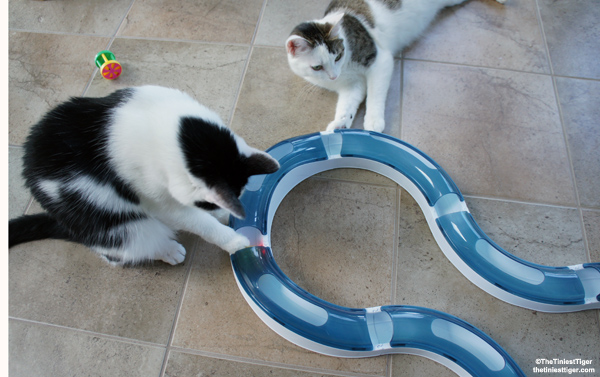
Frequently Asked Questions
Cat parents often have concerns about toy safety for their feline friends. Knowing what materials and types of toys are safe can help prevent accidents and keep cats happy during playtime.
What materials are considered safe for cat toys?
Safe materials for cat toys include natural fibers like cotton, wool, and sisal. Rubber and silicone are also good choices. Avoid toys with small parts that can come loose or be swallowed. Plush toys should have strong stitching to prevent stuffing from coming out.
Which cat toys are recommended by veterinarians?
Vets often suggest interactive toys like wand toys with feathers or fabric lures. Puzzle feeders and treat-dispensing toys are also popular choices. Soft balls and crinkle toys can provide safe solo play options. Many vets recommend rotating toys to keep cats interested.
How can I ensure the toys I leave with my cat are safe when unsupervised?
Remove string toys and dangling objects when you’re not around. Check toys regularly for wear and tear. Replace damaged toys promptly. Avoid leaving out small toys that could be swallowed. Provide sturdy scratching posts and cat trees for safe solo play.
What are the potential hazards associated with common cat toys?
String toys can cause choking or intestinal blockages if swallowed. Small parts may be ingested. Toys with bells or rattles inside can break open. Laser pointers may cause frustration if overused. Catnip toys should be monitored to prevent overstimulation.
Are there any specific toys that are safe for cats to chew on?
Dental chew toys made of rubber or silicone are safe options. Some cats enjoy chewing on cardboard or sisal toys. Avoid plastic toys that can break into sharp pieces. Always supervise chewing to prevent ingestion of toy parts.
Which cat toys are known to be safely manufactured in the USA?
Many pet supply companies make cat toys in the USA. Look for brands that use high-quality materials and follow safety standards. Check product labels for country of origin information.